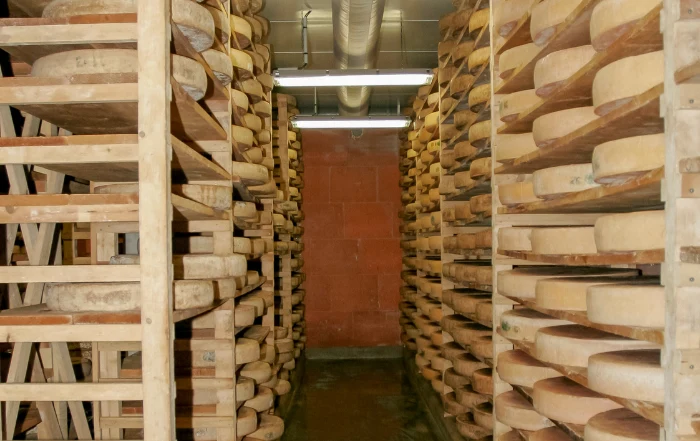Get ready for a cheesy tale (our apologies to those suffering lactose-intolerance) that will have you craving a delicious grilled cheese sandwich.
Believe it or not, the United States Department of Agriculture (USDA) has been hiding billions of pounds of cheese in secret caves in Missouri.
No, it’s not some strange cheese lover’s conspiracy—it’s actually a long-standing tradition with a twist.
Picture this: You have mountains of cheese, butter, and dry-milk powders. Where do you stash them?
Well, if you’re the USDA, the answer is simple: caves!
That’s right, a series of caves near Springfield, Missouri, have become the dairy storage solution for the government. It may sound a bit odd, but it’s all about finding a safe and climate-controlled spot for those dairy delights.
Now, why on earth is the government hoarding cheese in the first place? The story has two parts: why it started and why it continues.
It all starts with milk. Milk prices can be as unpredictable as the weather, jumping up and down like an excitable cow on a Pogo stick.
Limited supply and fluctuating demand make milk prices quite the rollercoaster. And to make matters more complicated, milk production surges in the spring, while demand peaks in the fall when the school year starts. So, what’s a government to do?
Well, they turned to cheese, of course!
Back in 1949, the USDA introduced the Dairy Product Price Support Program (now known as the Milk Price Support Program). When dairy product prices hit rock bottom, the USDA stepped in and offered to buy up the surplus at a stable rate. They scooped up millions of pounds of cheese, butter, and dry milk from producers who would have otherwise faced major losses.
The result?
The dairy market stabilized, producers had steady income, and product prices eventually rose. But here’s the catch—when dairy prices hit 125 percent of the support price, the USDA started selling off its massive cheese stash.
However, there was a downside.
While the USDA’s cheese purchases prevented prices from sinking too low, they also put a cap on how high prices could climb.
It was like being stuck in a cheese price limbo, not able to move out of either end of the spectrum. The operation was stable but costly, and it left many folks feeling a bit cheesed off.
So, the USDA had to change its game plan.
They started reducing support prices and buying less stock, but it didn’t make a huge dent.
That’s when they entered the next phase: ditching the automatic sell triggers.
Instead of selling off their dairy products when market prices hit the magic 125 percent mark, they left it up to the secretary of agriculture to decide when to release the cheese.
Talk about a political football match!
And if the secretary decided to hold onto the stockpile past the previous cutoff, you can imagine the cheese and butter mountains that piled up. It became a race against time to deal with them before they turned into cheesy disasters.
Eventually, the USDA said, “Enough is enough!” and ended the price support program in 2014. But guess what? They’re still hoarding cheese, although now it’s for a good cause—food assistance programs.
In the latest cold storage report, the USDA revealed that they have a whopping 1.5 billion pounds of cheese stashed away, along with 355 million pounds of butter, 211 million pounds of pecans (apparently, nuts are joining the party), and nearly a billion pounds of french fries (they really know how to store a lot of stuff!).
Although the current cheese hoarding isn’t meant to stabilize market prices, it still has an impact.
There’s a theory called “displacement.”
If the USDA provides free cheese to Americans in need through food banks and assistance programs, does it replace the cheese someone might have otherwise bought? It’s not a straightforward answer. If someone couldn’t afford cheese in the first place, receiving a pound for free wouldn’t affect their grocery plans.
But for someone who could have bought half a pound, the freebie would displace their purchase. It’s like a cheesy spectrum of displacement. The less it displaces, the more it helps market prices, but quantifying the exact help is trickier than finding the perfect cheese pairing.
And hold on to your cheese graters because there’s more! During the COVID-19 pandemic, the USDA created food boxes to distribute to struggling families. And guess what those boxes contained? You got it—cheese and other dairy products!
The government spent billions of dollars on this cheesy endeavor, and as a delightful consequence, cheese prices soared. It was an unintended consequence of their food assistance efforts, but hey, at least it kept the dairy industry afloat during challenging times.
Now, let’s get back to those hidden cheese caves. Here’s a fun fact: of the nearly 1.5 billion pounds of cheese, only around 300 million pounds belong to the USDA. The rest is owned by private companies and stored by the USDA. It’s like they’re guarding a treasure trove of cheesy delights for the nation.
So, there you have it, folks! The government is secretly stashing billions of pounds of cheese in Missouri caves, and their goal is to help both farmers and low-income cheese lovers. Should the government ever need to get rid of their stockpile quickly, we suggest stocking up on sourdough bread and nice butter.
Who’s up for a grand grilled cheese party in the heart of Missouri?
Let’s melt our worries away with a whole lot of cheesy goodness!




















